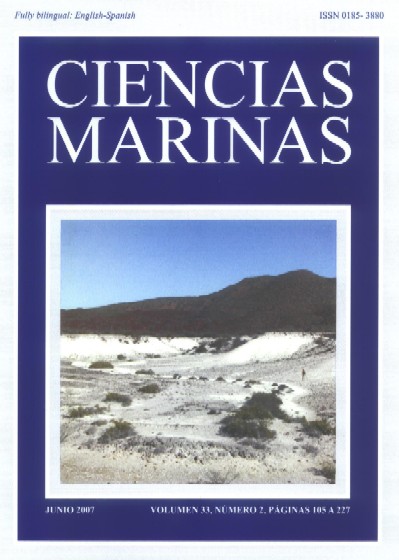Late Pleistocene coral-reef development on Isla Coronados, Gulf of California
Main Article Content
Abstract
Un extenso afloramiento de un arrecife identificado como Porites panamensis se presenta en sección transversal sobre las laderas de la Cañada Coronados en la parte sur de Isla Coronados en el Golfo de California, cercana a Loreto, Baja California Sur (México). De acuerdo con la razón de isótopos de uranio y torio determinada a una muestra de coral, el arrecife se desarrolló hace entre 121,000 y 127,000 años durante un levantamiento del nivel del mar correlacionable con el estadio isotópico marino 5e. Las colonias densas, en forma de bouquet, con abundantes ramificaciones, presentan una altura máxima de 1.1 m y un diámetro máximo de 1.1 m. El tamaño de la colonia disminuye claramente en dirección a tierra. Aproximadamente 60% de los corales crecieron desde un punto de fijación sobre una grava o canto de andesita. Estos clastos formaron un abanico de detritus en el piso de una gran laguna que estabilizó la arena de carbonato derivada de rodolitos fragmentados. Asociada con la superficie de grava se presenta una biota intermareal que incluye costras de alga calcárea coralina, bivalvos sésiles tales como Pseudochama janus, Modiolus capax, Barbatia reevseana y Arca pacifica, además de gasterópodos como Turbo fluctuosus, Acanthina tuberculata y Nerita bernhardi. El cuerpo arrecifal subsiguiente cubrió un área mínima de 1.3 ha. Mediante una estimación moderada de una colonia de coral por metro cuadrado, el depósito arrecifal en la Cañada Coronados representa la amalgama de 13,000 colonias. Sin ser ecológicamente cogenéticas, estructuras arrecifales adicionales pueden haber cubierto hasta 50 ha en la Cañada Coronados de Isla Coronados. La orientación sureña del arrecife fósil en Isla Coronados es un patrón comúnmente encontrado en otras islas y bahías protegidas de la costa peninsular en la parte baja del Golfo de California.
Part of an extensive fossil reef composed of corals attributed to Porites panamensis is exposed in cross section along the walls of Cañada Coronados on the south side of Isla Cononados in the Gulf of California, near Loreto, Baja California Sur (Mexico). Based on laboratory analysis of uranium/thorium isotope ratios derived from a coral sample, the reef developed sometime between 121,000 and 127,000 years ago during a highstand in sea level correlative with marine isotope substage 5e. Densely packed bouquet-shaped colonies with multiple branches reach a maximum height of 1.1 m and maximum diameter of 1.1 m. Colony size diminishes markedly in the landward direction. About 60% of the corals show growth from an attachment point on andesite cobbles or small boulders. These clasts formed a debris apron on the floor of a large lagoon that effectively stabilized carbonate sand derived from crushed rhodoliths. Associated with the cobbled surface is a transitional intertidal biota that includes clast-encrusting coralline red algae, fixed bivalves such as Pseudochama janus, Modiolus capax, Barbatia reevseana, and Arca pacifica, in addition to gastropods such as Turbo fluctuosus, Acanthina tuberculata, and Nerita bernhardi. The succeeding reef body covered a minimum area of 1.3 ha. Using a conservative estimate of one coral colony per square meter, the reef deposit at Cañada Coronados represents the coalescence of 13,000 colonies. Not strictly coeval in ecological age, additional reef structures may have occupied up to 50 ha around the Cañada Coronados site on Isla Coronados. The southern exposure of fossil reefs on Isla Coronados is a pattern commonly found on other islands and sheltered bays on the peninsular coast in the lower Gulf of California.
Part of an extensive fossil reef composed of corals attributed to Porites panamensis is exposed in cross section along the walls of Cañada Coronados on the south side of Isla Cononados in the Gulf of California, near Loreto, Baja California Sur (Mexico). Based on laboratory analysis of uranium/thorium isotope ratios derived from a coral sample, the reef developed sometime between 121,000 and 127,000 years ago during a highstand in sea level correlative with marine isotope substage 5e. Densely packed bouquet-shaped colonies with multiple branches reach a maximum height of 1.1 m and maximum diameter of 1.1 m. Colony size diminishes markedly in the landward direction. About 60% of the corals show growth from an attachment point on andesite cobbles or small boulders. These clasts formed a debris apron on the floor of a large lagoon that effectively stabilized carbonate sand derived from crushed rhodoliths. Associated with the cobbled surface is a transitional intertidal biota that includes clast-encrusting coralline red algae, fixed bivalves such as Pseudochama janus, Modiolus capax, Barbatia reevseana, and Arca pacifica, in addition to gastropods such as Turbo fluctuosus, Acanthina tuberculata, and Nerita bernhardi. The succeeding reef body covered a minimum area of 1.3 ha. Using a conservative estimate of one coral colony per square meter, the reef deposit at Cañada Coronados represents the coalescence of 13,000 colonies. Not strictly coeval in ecological age, additional reef structures may have occupied up to 50 ha around the Cañada Coronados site on Isla Coronados. The southern exposure of fossil reefs on Isla Coronados is a pattern commonly found on other islands and sheltered bays on the peninsular coast in the lower Gulf of California.
Downloads
Download data is not yet available.
Article Details
How to Cite
Johnson, M. E., Lopez-Perez, R. A., Ransom, C. R., & Ledesma-Vazquez, J. (2007). Late Pleistocene coral-reef development on Isla Coronados, Gulf of California. Ciencias Marinas, 33(2), 105–120. https://doi.org/10.7773/cm.v33i2.1011
Issue
Section
Research Article
This is an open access article distributed under a Creative Commons Attribution 4.0 License, which allows you to share and adapt the work, as long as you give appropriate credit to the original author(s) and the source, provide a link to the Creative Commons license, and indicate if changes were made. Figures, tables and other elements in the article are included in the article’s CC BY 4.0 license, unless otherwise indicated. The journal title is protected by copyrights and not subject to this license. Full license deed can be viewed here.

